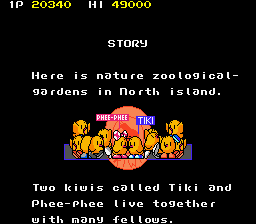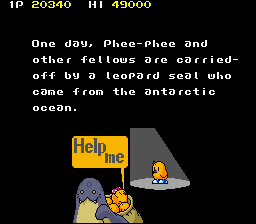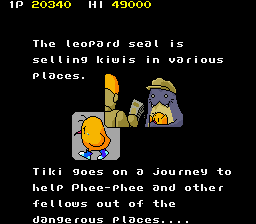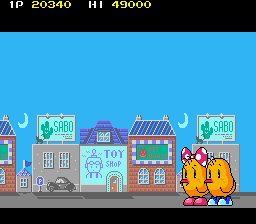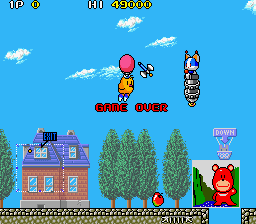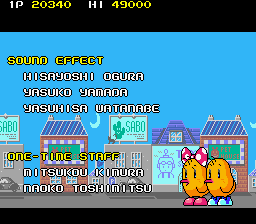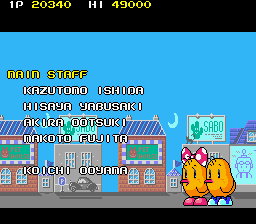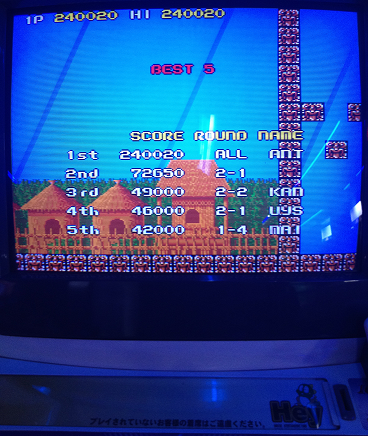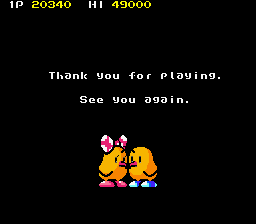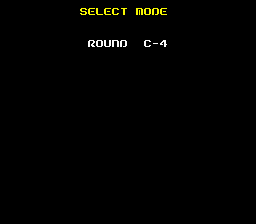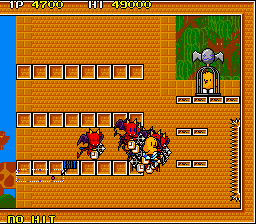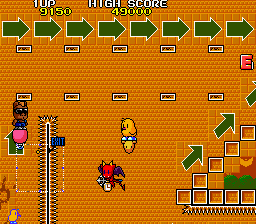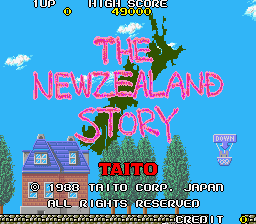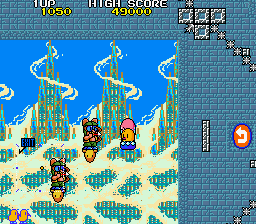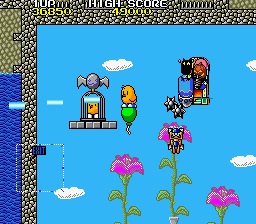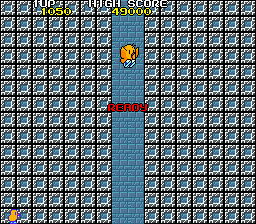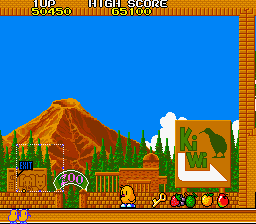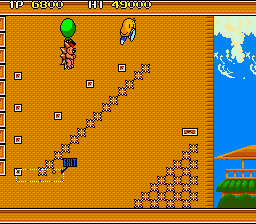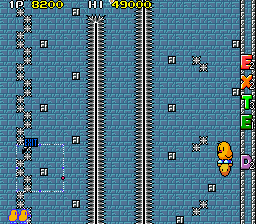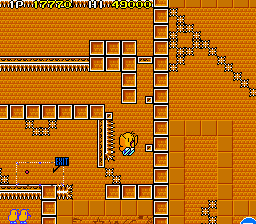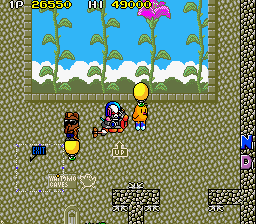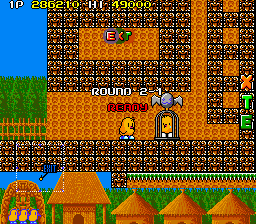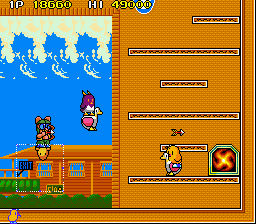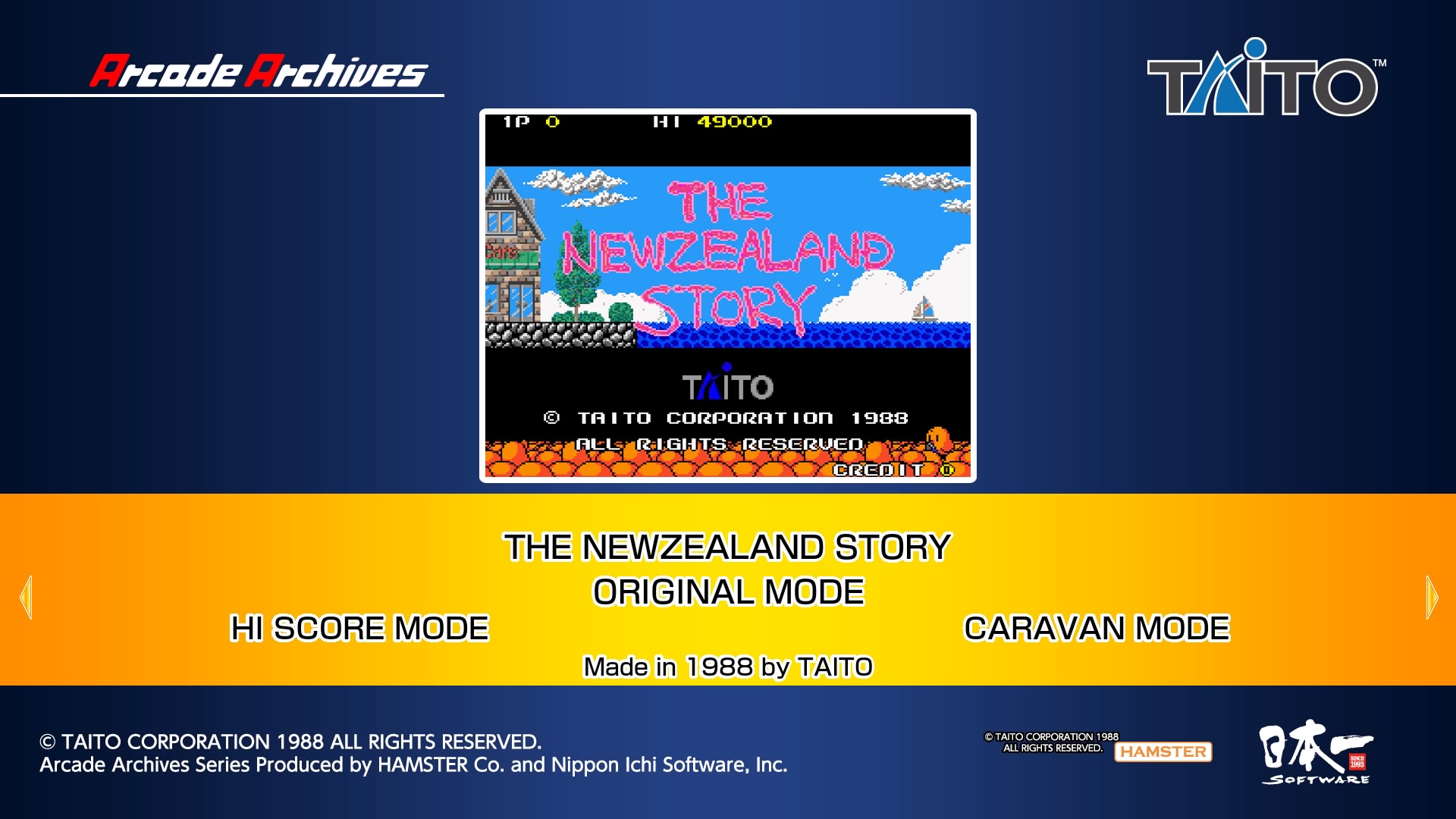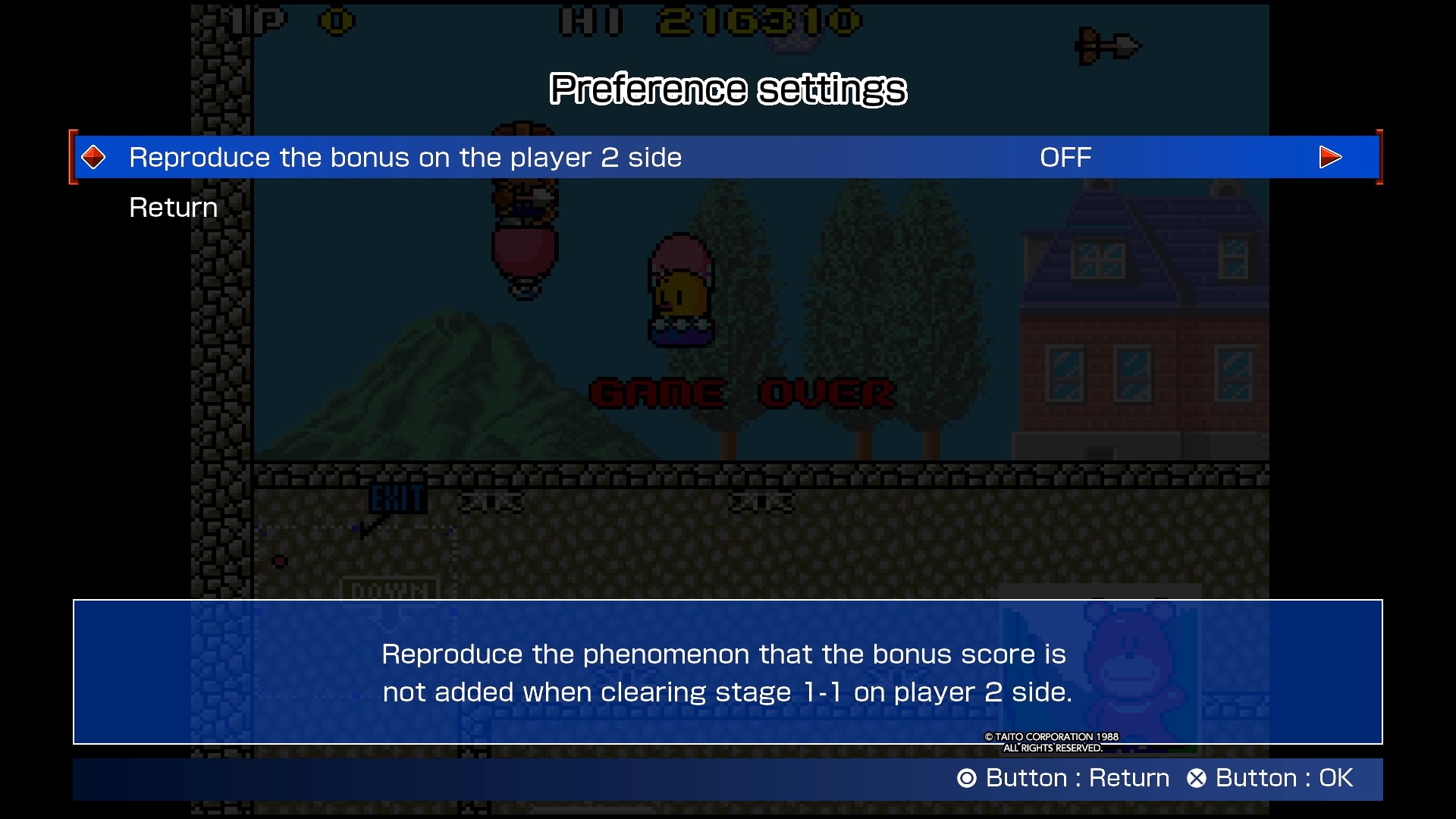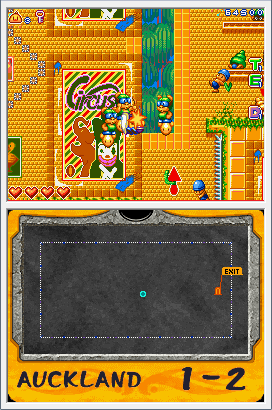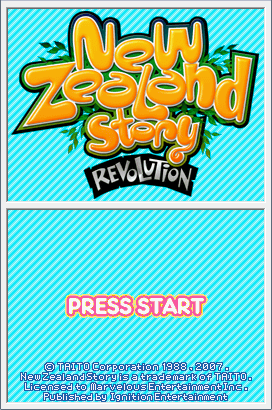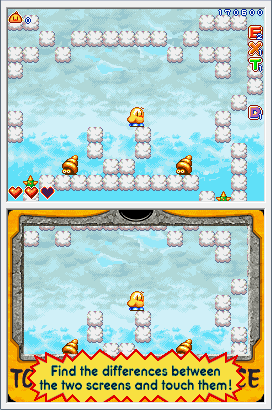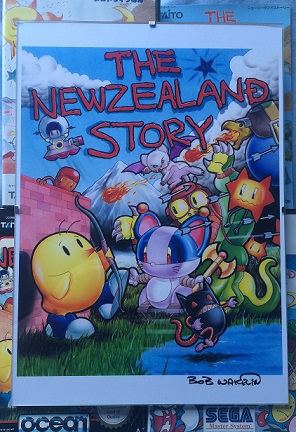| System |
Comments |
Shot |
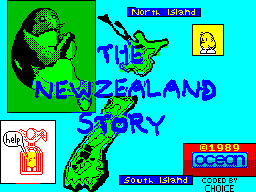
ZX Spectrum
1989,
Choice Software |
Hello, Speccy, my old friend. I've come to play with you again. The ZX Spectrum port of The NewZealand Story was the very first version of the game I played when I was only slightly smaller than I am now. As such, you might expect me to pop on the ol' rose-tinted glasses and put this version above all the others. Don't be so naive, buster! The little computer actually puts up a decent fight here. Choice Software decided to go for the 'mono-colour' approach for this one (see also: Psycho Soldier, Final Fight) and while it looks a bit plain, it does the job. Game-wise, it's a bit choppy with the scrolling and the camera is a bit slow, but it actually controls pretty well. Vehicles especially control like a treat! A heavily-compromised port, and it's a bloody multi-loader too, so make sure you pop the kettle on in advance, but it really tries its best, bless it. Additionally, as pointed out by Kak2X, this version has the banana point item dummied out of the arcade game! |
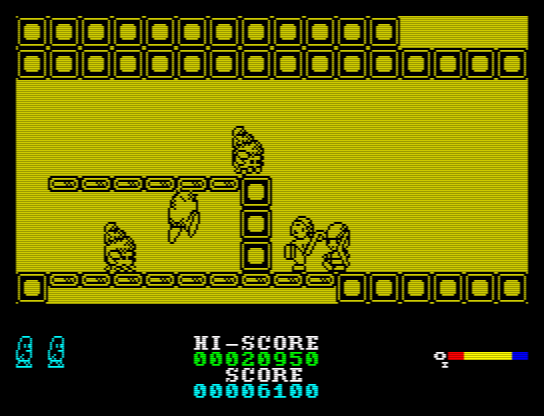
|
|
|
|
|
|
|
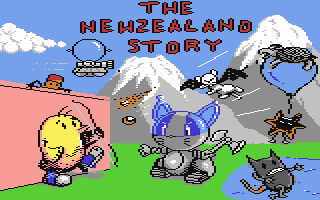
Commodore 64
1989,
Richard Palmer |
A pretty respectable port, all things considered. Movement's a little slow, and you can only have two arrows on-screen at once, but surprisingly it keeps in the EXTEND letters (as random drops only this time) and there's quite a lot of colours in-use. However, the Tiki sprite looks very awkward , like he's arching his back for some reason, and it loses a few cute points in that regard. The scrolling's OK, colours are nice, and it doesn't seem to control too bad, so this is a pretty acceptable 8-bit rendition of the game, all things considered. Not much else to say on it beyond that, really, so we'll leave it at that.
Oddly, a different version by Colin Gordon and Dave Clarke of Choice Software was being made but canned when Ocean brought the conversion in-house. Eventually, the bones of this cancelled version would become... CJ's Elephant Antics. |
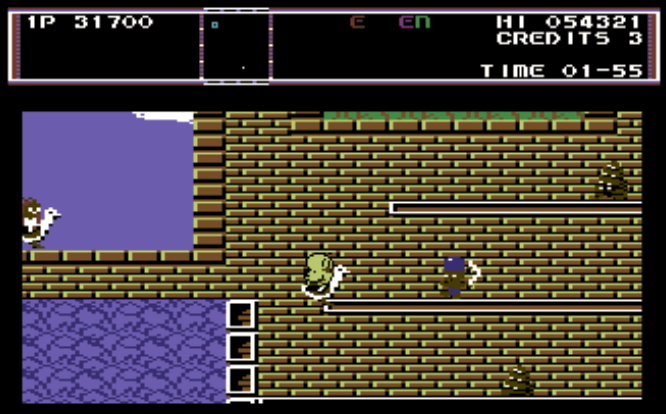
|
|
|
|
|
|
|
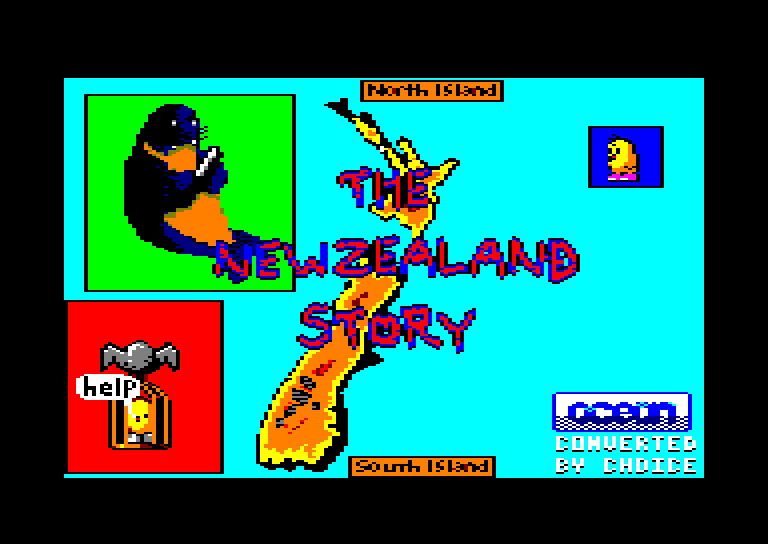
Amstrad CPC
1989,
Choice Software |
Crikey blimey o' riley, this one's rough as old guts! It's similar to the ZX Spectrum version, in that the backgrounds are gone and the game takes its time moving the camera along, but unlike the Speccy port, this one runs awfully. The scrolling and movement was a bit choppy on the ZX, but this is way, way worse and much slower, making it an absolute chore to play. Even given the addition of proper colours, you'd be much better off trying the ZX Spectrum version, and even with the vintage of the hardware taken into consideration, this is bad. |
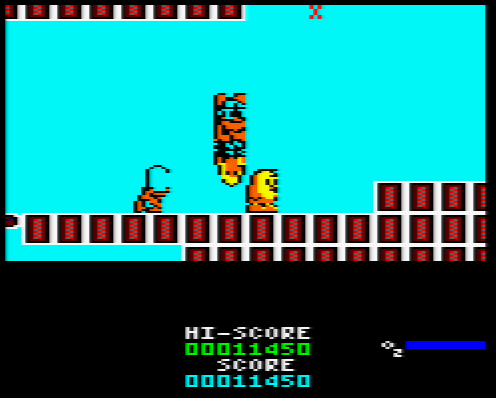
|
|
|
|
|
|
|
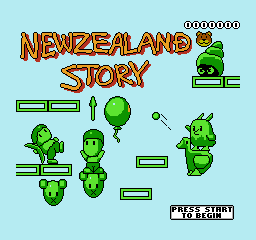
NES
1991,
Software Creations |
Of the console-based ports of the game, the NES port is my personal favourite. Admittedly, on paper it doesn't sound that great- the enemy, item and vehicle rosters have been cut (probably the least amount of all the console ports, the Master System version in particular has a lot more), the graphics have been scaled back considerably (the colours in particular are pretty bad) and the levels are mostly the same but they're truncated a little in parts. That said the gameplay itself is definitely in-tact, it runs at a decent clip, it has the warps and, graphics and cut stuff aside, the game mechanics are solidly reproduced and there's no choppy gameplay like the nicer-looking Master System port. It also has the benefit of the full theme as remade by Tim Follin and it's by far the most stompin' version of the song. A lot of compromises in this port, then, but I think it stands up pretty well, all things considered. Weirdly, no Famicom release for this, so you'll have to find the EU or US version.
(Note: This version was released in the US as Kiwi Kraze. Yes, it's an awful name.) |
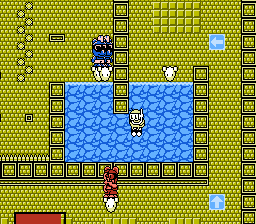
|
|
|
|
|
|
|
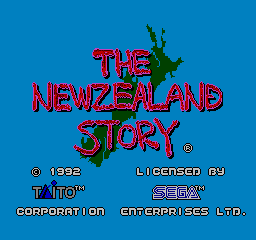
Master System
1992,
TekMagic |
Oh boy, this version. Visually, this is a lot closer to the arcade game than most of the home computer versions, and even the NES and PC Engine ports. On a technical level, it's quite impressive! The controls and physics are a little off- Tiki moves and falls a lot faster, but swims a lot slower, and overall it feels a little choppy when it comes to scrolling- but the vehicle control is fine, and in terms of content, it loses the EXTEND letters but keeps (most of) the warps. As impressive as it is, though, I really don't like this version due to the viciousness of the enemies. Any enemies who use weapons no longer stop to use them- Bobs, for instance, can move freely while preparing their arrow shot, which means you can get killed very easily because the telegraphing of their attacks is much, much shorter. Also, 12-second music loop like most of the home computer versions. So, this one looks very nice, but it's way harder than the arcade game in a bad way, and ahh, I'm just not keen. Sorry! |
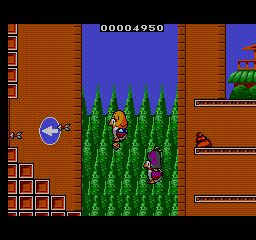
|
|
|
|
|
|
|
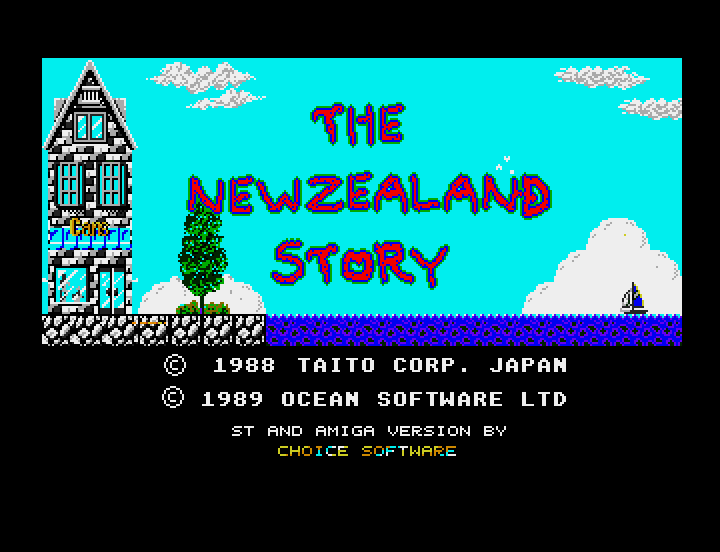
Amiga
1989,
Choice Software |
Of all the home computer ports, the Amiga was the one I'd heard the highest praise for- shockingly I've never owned an Amiga, so playing this one for the first time was interesting! It's pretty OK, for what it is. Similar to a couple other ports, Tiki runs a bit too fast, and you have to use Up to jump and operate vehicles, but that's not a huge deal. It keeps a lot of elements in, such as EXTEND bubbles and Mr. Wakelin who was cut from a lot of other versions, but not every enemy is in, and many areas have been compacted to save space presumably. Two things in particular are kinda annoying- like the C64 version while there are still mid-air checkpoints, you don't get given a free hot air balloon so Tiki will just plummet to the ground, and also enemies can often just shoot through walls. Also, while less an annoyance, the enemy spawns are set by triggers that don't have a cool-down time like the arcade, so you can get swarmed very easily. But yeah, considering the specs, this is about what I expected. A very respectable conversion for the time and system, and I'd put it ahead of some of the console ports! |
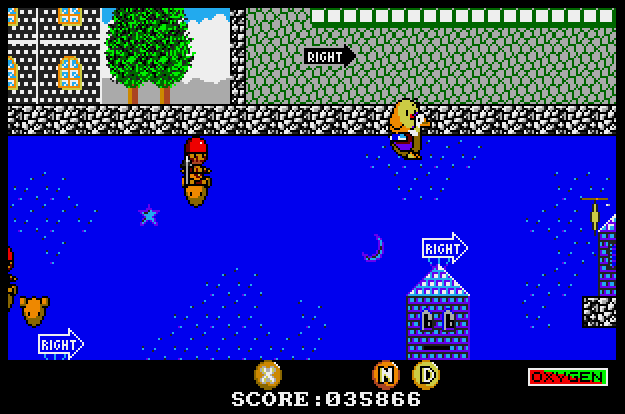
|
|
|
|
|
|
|
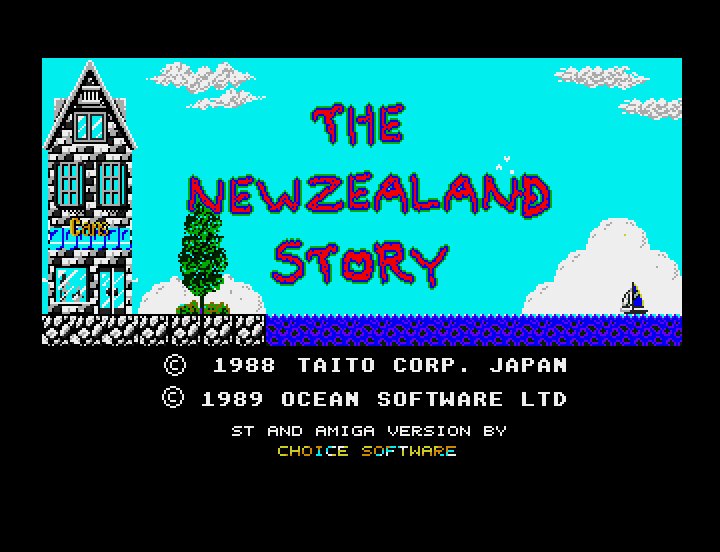
Atari ST
1989,
Choice Software |
We don't have much to say about this, as it's very similar to the Amiga port- it was done by the same developers, and the title screen even says both Atari ST and Amiga on the title! The Amiga version is the better of the two though- this adds a border to the side where the game's logo and basic information resides so you have slightly less screen real estate to work with, and it's a little choppier than its Amiga counterpart. This isn't the same case as the ZX and CPC versions though, as the Atari ST does the job well enough, if a little less elegantly than the Amiga one. |
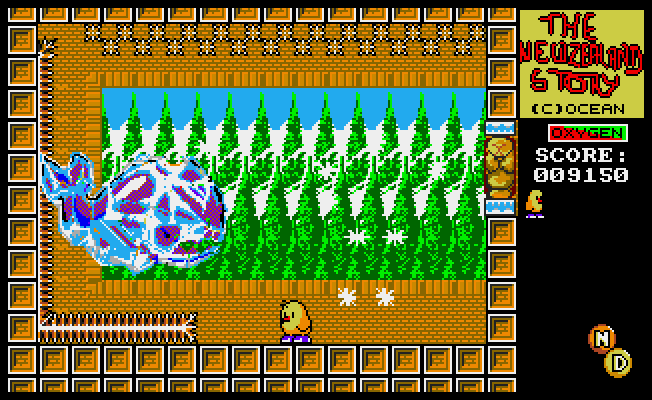
|
|
|
|
|
|
|
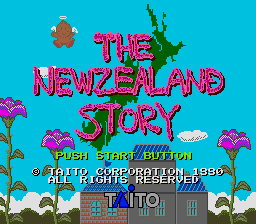
Mega Drive
1990,
Dragnet? |
It's unclear if Dragnet was solely responsible for this one, as not even GDRI is certain. At least they have a name- before then it was just a question mark! Adding to the mystery, the level set is based on the 'World, prototype' revision, which means things start off rough, so perhaps you could consider this a 'For Super Players' version. The opening rounds will test you far more than the rest of the game, especially Round 1-4! It doesn't help that the physics are a wee bit wonky- Tiki will 'shift' a few pixels to the side when jumping and moving through platforms, and the collision detection is very iffy in places, killing you when you could've sworn you were safe (the spike jump in Round 5-1 is a real killer in particular). It's a shame because otherwise this is a pretty unique port of the game, and visually it's very close to the arcade game. It also keeps the EXTEND bubbles, has warps (although they don't always match up as there's no bonus rooms present here) and has an exclusive game mechanic- Tiki can change the throwing arc of his bombs by throwing as he jumps. Had it stuck to the original level set and tightened things up, it could've been one of the best home ports! Certainly one of the most interesting, at least.
As a bonus, here's a speedrun showing off some deathskips and warp points! |
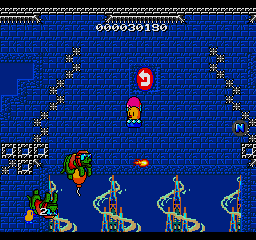
|
|
|
|
|
|
|
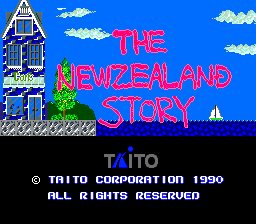
PC Engine
1990,
Aisystem Tokyo |
The PC Engine port is a farce. Dreadful stuff. For a start, visually it's very off as half the colours are wrong! I'm not talking 'Tiki's shoes are a slightly different shade of blue', I'm talking 'I had to check a video of this on real hardware to make sure it wasn't emulation trouble' (this one). Colours of a lot of individual sprites are wrong, but it really gets wild from Round 3-1 onwards where the background colours look inverted and eye-straining. It's a sight to behold. However, the real bugbear of this port is in the controls- Tiki's jumps feel off and the vehicles now control like total butt. Tap the direction button on a vehicle and Tiki will move almost a whole block in that direction. It's like they can only move in blocks! Needless to say, this makes controlling vehicles a lot worse- even home computer ports were better than this, and it makes some areas impossible to navigate with them. Oh, and the game abruptly ends after the first half of Round 4-4, sending you straight to Azarashi, omitting the rest of World 5. In its favour, this version does keep many Warps, but of the home console versions of the game this one's the worst by a wide margin, which is a shame- much like the Mega Drive port, the PC Engine could've been up to the task if this was given the proper love and care it needed. |
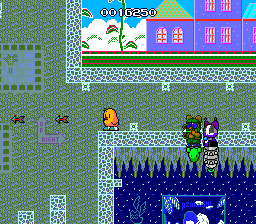
|
|
|
|
|
|
|
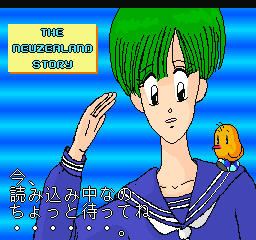
Sharp X68000
1989,
Sharp / SPS |
Oof. This one really should've been a home run. Contemporary home computer hardware? Check. SPS, who did the great port of The Fairyland Story? Check. EXTEND balloons, Heaven and Warps? That's a triple-check. Something has gone a bit amiss with this version though- it looks the part, sounds it too (although it's not 100%, it's closer than most) but it feels... Wrong. The main issue here is that, similar to the Mega Drive port, the collision detection with blocks is wonky and Tiki will often 'shift' when he's jumping through them, which can throw you off. Vehicle physics are also not accurate, with some vehicles being a lot faster than they should be. Also, enemy behaviour is all over the place, with boss patterns being extremely wrong in particular. Aesthetically it is very close, but controls and mechanics-wise this is not the arcade game, so do not expect a one-to-one conversion! To its credit, this port does have a feature not seen in any other version, not even the arcade- upon completing a Heaven round, you end up in a new area where you choose from five warps, each leading to a short, brand new map you must clear before returning to the main game (including boss rematch rooms!). Just keep your expectations in check, OK? |
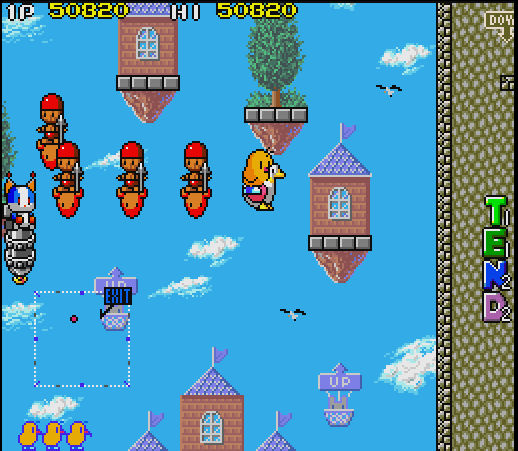
|
|
|
|
|
|
|
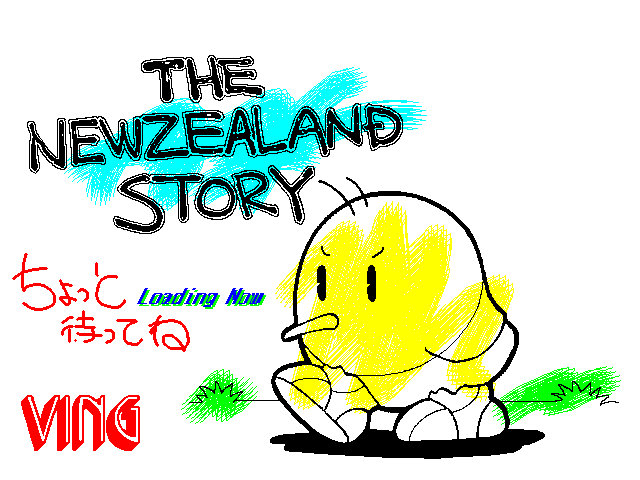
FM Towns Marty
1989,
Ving |
Now this port, on the other hand, is much closer. If you absolutely, positively need a high-end home port of The NewZealand Story on vintage Japanese hardware, the FM Towns version is the one to go for. This one has all the features- EXTEND bubbles, the Heaven rounds, warps- and unlike the X68K version, allows you to queue up your jumps before you hit the ground. Controls-wise, this is very, very close (with only some minor differences with vehicle physics), which should come as no surprise given this was ported by Ving, whose working relationship with Taito gave us a slew of excellent ports for the Marty and Sega Saturn. There's only a few elements that aren't perfect- the sound is not the same as the arcade version (much less so than the X68K port) and your only game options are the resolution and Normal and Easy difficulties (in the past I said there was no flapping, but there is- that was due to emulator problems, it's actually easier than the arcade game). Unlike the X68K version though, this is much more faithful to the source material, and so is awarded the accolade of Best Contemporary Port. You have done well, FM Towns Marty! |
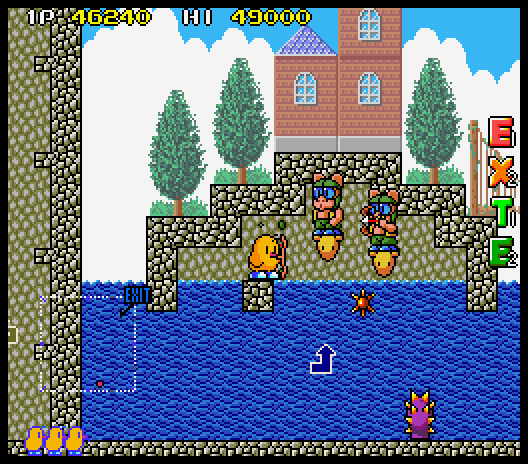
|
|
|
|
|
|
|
Taito Memories
Gekan
PS2, 2005,
Taito |
We now enter the era of emulation and... Alright, OK, you got us. We, uh, don't have this version to test. Not our fault, we swear. Unfortunately, the PS2 Taito Memories collections have skyrocketed in price, and we weren't able to grab this particular instalment for this article. That said, we do know a little bit about this version and is probably the best of the emulations available from that era. It uses the 'Japan, old version' ROM (as it should be) and has the bare minimum of dip switches (number of lives and difficulty) and customisable controls. Nothing fancy about this version (not even a viewable flyer) but it is the arcade original emulated, exactly as you expect. |

|
|
|
|
|
|
|
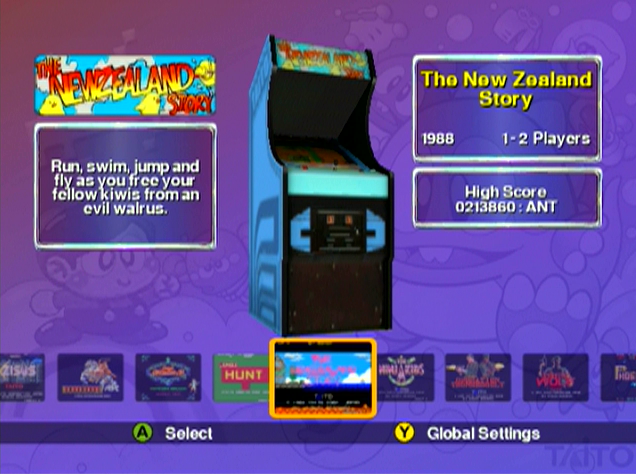
Taito Legends
PS2 / Xbox / PC, 2005,
Atomic Planet Entertainment |
The Taito Legends packs were essentially Empire Oxford's own attempt at Taito Memories, with this first one developed for them by Atomic Planet of Mega Man Anniversary Collection infamy. Sadly this set has some strange oversights, such as having no customisable controls on console, weird 'presets' for game options and not saving scores if you customise them and reversing the traditional NES style 'left button to shoot, right button to jump' standard. In The NewZealand Story in particular, they used the 'Japan, old version' set as expected, but in the Xbox version at least (need to confirm this on PS2 and PC), they accidentally left the debug dipswitch on, meaning Tiki cannot drown. That's a bit of an oversight, to be sure. The easiest of the three emulated versions to find, but with problems. On the plus side, the game came with one of six random postcards, one being The NewZealand Story's flyer art, and you can view the flyer in-game too! |
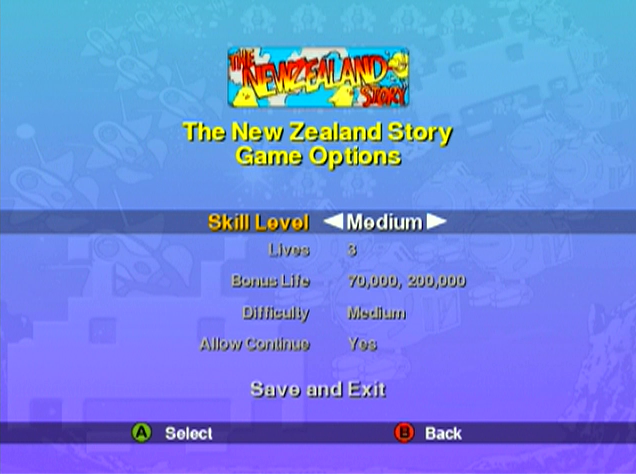
|
|
|
|
|
|
|
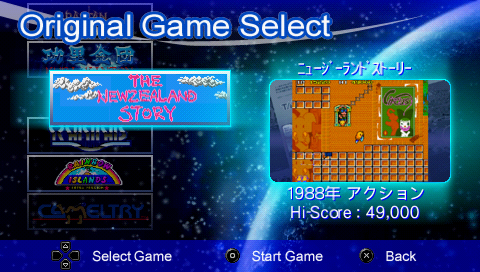
Taito Memories
Pocket
PSP, 2006,
Taito |
Yep, it's pretty much emulation from here on out. Essentially a pocket-ified version of the Taito Memories collections on PS2, Taito Memories Pocket uses the same 'Japan, old version' ROM and has the same options, meaning basic difficulty and lives dipswitches and remappable controls. Nothing else particularly fancy here, but it is the game in its first portable format, which is nice. |
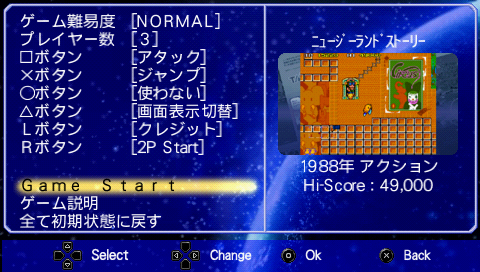
|
|
|
|
|
|
|
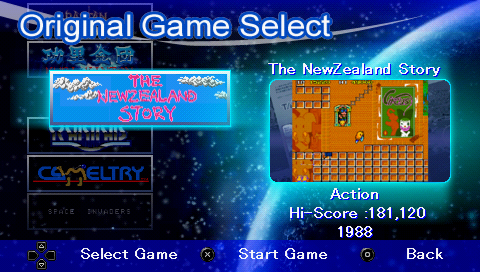
Taito Legends:
Power-Up
PSP, 2006,
Taito |
This is the Western version of Taito Memories Pocket and changes a few games- ditching Rainbow Islands Extra and adding some more Space Invaders games- but also makes a change to The NewZealand Story! For whatever reason, the 'World, new version' revision of the arcade game was used instead, meaning a slightly remixed set of opening levels. At least they didn't use the prototype by mistake, eh? Other than that, this has the same options as the Taito Memories version, so basic difficulty and lives options and remappable controls are your lot, no extras of any kind. Sorry! |
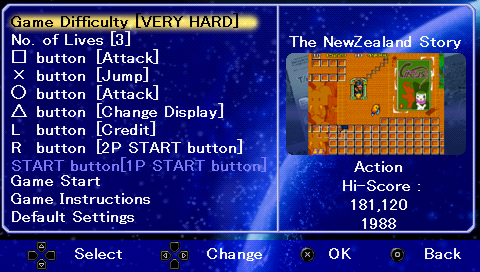
|
|
|
|
|
|
|
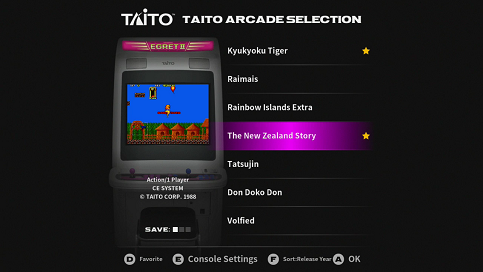
Taito Egret II Mini
2022,
Taito |
Another straight emulation of the game, but this is a special case- it's a miniaturised plug-and-play Taito Egret II cabinet! This unit uses the 'Japan, old version' revision of the arcade game as should be expected, and the emulation is pretty much spot-on as far as I can tell- however, input lag varies depending on the amount of voltage getting to the unit, so be careful. You can play either on the built-in screen or on a television via HDMI and use the controls on the unit or USB devices, plus there's a basic filter and screen borders you can toggle on or off. Options are a little limited- extends, lives and difficulty with no remappable controls (but you get rapid fire on the top row of buttons)- but while this is a very good version of the game, you're gonna be paying a lot for it. Still, you get 39 other Taito games with the base unit (plus 10 more with the paddle / trackball set and another 10 with another expansion pack including Cleopatra Fortune) so Taito fans are basically set with this one.
|
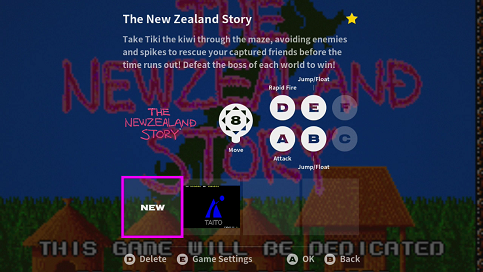
|
|
|
|
